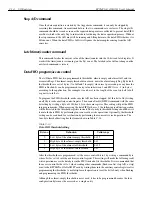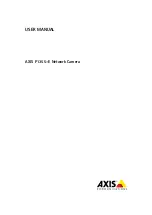
B-2
PCMCIA Interface
KPCMCIA-12AIAOH User’s Manual
NOTE
A typical user of this manual does not need to read the material in this
section. If you write a custom program, write it to work through DriverLINX,
using the many interface and support features of DriverLINX. Register-level
programming of the card is not recommended. This section is provided only
for an advanced programmer who must write a specialized driver.
Introduction
Information in this section is provided for those who need low-level PCMCIA interface details of
the KPCMCIA-12AIAOH PC card. The client driver or the enabler that comes with the PC card
is sufficient for most applications.
The KPCMCIA-12AIAOH PC card performs data acquisition for all host computers equipped
with a version 2.1 compliant PCMCIA interface. The PC card, which is the name given to all
PCMCIA interface cards, has a form factor of type II (5mm thick).
Due to the PCMCIA interface, the PC card is highly flexible with respect to addressing and inter-
rupt level use. It can be configured either as a memory only interface or as an I/O interface and
can be powered up or down with the help of the PCMCIA card and socket services software. The
KPCMCIA-12AIAOH PC card provides a single interrupt that is routable to any system interrupt
via the PCMCIA socket controller.
Two sets of registers are on the KPCMCIA-12AIAOH PC card: the configuration registers and
program registers.
The configuration registers are those defined in the PCMCIA 2.1 specification. The PCMCIA
configuration registers are located in the PC card’s configuration space at offset 8000H. Config-
uration space also contains the Card Information Structure (CIS). This memory is located at offset
0000H in the configuration space. The CIS memory contains information about the PC card as
defined by the PCMCIA 2.1 specification. The configuration and power-up/down control of the
PC card should be carried out through the standard card and socket services software even though
they can be achieved with an enabler.
Program registers are the registers that fall under program control and belong to the KPCMCIA-
12AIAOH PC card. The I/O location of these registers are controlled by the PCMCIA socket con-
figuration and by the contents of the PCMCIA configuration registers. See the descriptions in
Appendix C for more information.
Two PCMCIA configuration registers are supported by the KPCMCIA-12AIAOH PC card: the
configuration option register and the card configuration and status register. Refer to Table B-1.
Table B-1
PCMCIA configuration registers
Offset
Access
Description
0x8000
R/W
Configuration option register
0x8002
R/W
Card configuration and status register
Summary of Contents for KPCMCIA-12AIAOH
Page 11: ...1 Introduction...
Page 15: ...2 Installation...
Page 17: ...3 Theory of Operation...
Page 25: ...4 I O Connections...
Page 28: ...5 Optional Accessories...
Page 30: ...A Specifications...
Page 33: ...B PCMCIA Interface...
Page 36: ...C I O Registers...
















































